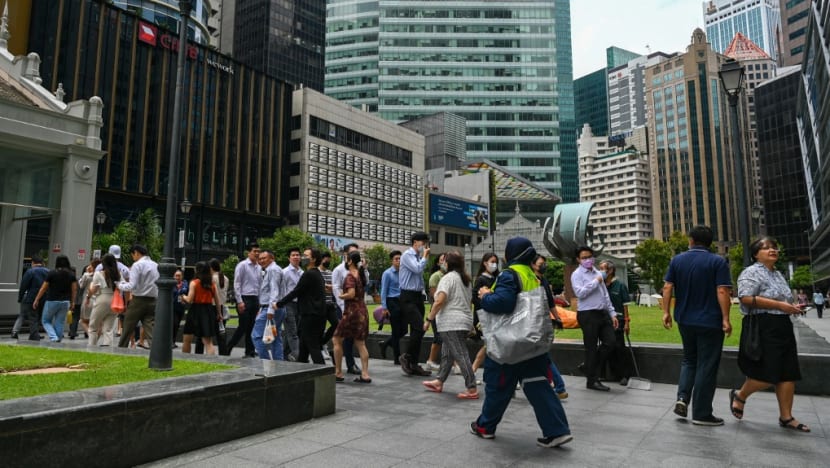CNA Explains: Slump and recovery – what is the current state of the Singapore economy?
Singapore narrowed its projection for economic growth in 2023 on the back of a weak outlook for external demand.

People walking in Raffles Place in Singapore. (Photo: AFP/Roslan Rahman)
SINGAPORE: Singapore is set for tepid growth through the rest of the year, as the economy sees diverging prospects for its different sectors, economists said on Friday (Aug 11).
“The story of Singapore’s economy is really a story of two different parts,” said Oxford Economics’ senior economist Alex Holmes.
Singapore has narrowed its projection for economic growth this year, citing a weak outlook for external demand.
The growth forecast was trimmed to a range of 0.5 to 1.5 per cent, down from an earlier estimate of 0.5 to 2.5 per cent, the Ministry of Trade and Industry (MTI) said on Friday (Aug 11).
So far in 2023, Singapore's economy has seen tepid growth. On a year-on-year basis, gross domestic product grew 0.4 per cent in the first three months before improving slightly to 0.5 per cent in the second quarter.
On a quarter-on-quarter seasonally adjusted basis, the economy eked out growth of just 0.1 per cent in the second quarter, a reversal from the 0.4 per cent contraction in the first quarter.
WHAT'S HURTING EXTERNAL DEMAND?
Singapore is a small economy that is highly dependent on external demand.
From 2015 to 2019, external demand accounted for around 67 per cent to 72 per cent of Singapore’s GDP, according to a piece published by MTI in its first-quarter economic survey in May.
Key markets include the United States and the Eurozone, but growth prospects in these economies are set to slow even more in the second half of the year when the effects of elevated interest rates take hold.
China’s growth is also expected to moderate through the rest of the year, as the post-pandemic recovery in services slows in tandem with deteriorating consumer confidence.
In addition, the ongoing global electronics downturn is “proving to be a little bit more protracted” than initially thought, MTI said.
A gradual recovery is only “expected towards the end of the year at the earliest” – a view echoed by HSBC economist Yun Liu.
“Trade headwinds are not dissipating,” said Ms Liu. “While there are some initial signs that point to stabilisation in the tech cycle, tech-heavy economies have not seen a meaningful turnaround.”
On top of that, there remains a host of uncertainties such as more persistent-than-expected inflation in the advanced economies, as well as the risk of escalation in the war in Ukraine and geopolitical tensions among major powers.
WHICH SECTORS ARE IMPACTED?
The manufacturing sector, which is among those most reliant on external demand, has contracted for three consecutive quarters on a year-on-year basis.
The sector – which accounts for about one-fifth of the local economy – shrunk by an annual 7.3 per cent in the second quarter, tumbling further from the 5.4 per cent contraction in the preceding three months.
“Manufacturing remains the weakest link for now, mainly due to the ongoing drag from electronics and precision engineering clusters amid the prolonged global electronics downturn and the ongoing US-China strategic rivalry may not help,” said OCBC’s chief economist Selena Ling.
Other vulnerable industries include the finance and insurance sector, which is feeling the squeeze from restrictive financial conditions and the global economic slowdown.
That said, the bulk of the services sectors are holding up on the back of the post-pandemic recovery in international air travel and tourism.
For example, travel-related services – which account for about 10 per cent of Singapore’s GDP – continue to “show much-needed momentum”, said Ms Liu. There is further room for growth, given how the local transport and accommodation sectors have not returned to pre-pandemic levels, she added.
Singapore is also “one of the frontrunners” in the region to see a return of Chinese visitors, given its quick restoration of direct flights with China. China’s recent resumption of a 15-day visa-free for Singaporeans will deliver another boost to the travel sector, Ms Liu said.
The prospects for other consumer-facing sectors, such as retail and food and beverage services, are also looking rosy, with support from resilient labour market conditions and the recovery in inbound tourism.
“We expect healthy expansion (for services) in the second half,” said DBS economist Chua Han Teng.
“(These sectors) are likely to enjoy tailwinds from the ongoing normalisation in international travel amid returning Chinese tourists, and large-scale events including the Singapore Grand Prix.”
COULD SINGAPORE DIP INTO RECESSION?
Based on current growth estimates, a recession is not on the cards of private-sector economists who have their full-year forecasts for the Singapore economy ranging from 0.7 per cent to 2 per cent.
The services industries will provide “some pockets of resilience that will help prevent a recession this year”, said Ms Liu, who gave a full-year growth estimate of 1.8 per cent.
“We expect growth to turn modestly in the second half of 2023 on the back of trade stabilisation and an ongoing recovery in the travel-related sectors,” she added.
But others are less optimistic about the boost from services.
“We still believe services could fare better in 2023 but the uplift from services may not be as promising as we had anticipated,” said UOB’s senior economist Alvin Liew.
He added that the services sector may also feel the impact of risk factors such as weaker global growth and issues in the US banking sector.
Concurring, Mr Holmes said while inbound tourism has helped to provide a lift to the economy, overall growth will remain soft.
“The thing is that Singapore’s economy is very export-focused. Unless that kind of turns the corner, soft growth is going to be here to stay for a while,” he told CNA.
Ms Liu noted that the labour market will warrant “a close watch” given signs of softening such as slowing job creation, particularly in the services sector.
Amid softer growth, businesses will continue to grapple with elevated cost pressures, although the increase is set to gradually ease, said DBS’s Mr Chua.
For example, the pace of labour cost increases is set to moderate amid slower economic growth and softer labour demand, he wrote in a note.

















